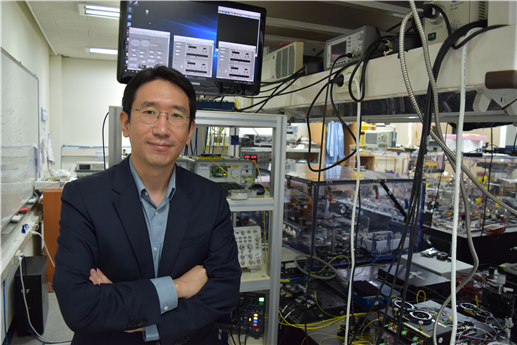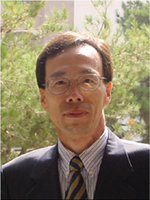TOF
-
 Scientist of October: Professor Jungwon Kim
Professor Jungwon Kim from the Department of Mechanical Engineering was selected as the ‘Scientist of the Month’ for October 2020 by the Ministry of Science and ICT and the National Research Foundation of Korea. Professor Kim was recognized for his contributions to expanding the horizons of the basics of precision engineering through his research on multifunctional ultrahigh-speed, high-resolution sensors. He received 10 million KRW in prize money.
Professor Kim was selected as the recipient of this award in celebration of “Measurement Day”, which commemorates October 26 as the day in which King Sejong the Great established a volume measurement system.
Professor Kim discovered that the time difference between the pulse of light created by a laser and the pulse of the current produced by a light-emitting diode was as small as 100 attoseconds (10-16 seconds). He then developed a unique multifunctional ultrahigh-speed, high-resolution Time-of-Flight (TOF) sensor that could take measurements of multiple points at the same time by sampling electric light. The sensor, with a measurement speed of 100 megahertz (100 million vibrations per second), a resolution of 180 picometers (1/5.5 billion meters), and a dynamic range of 150 decibels, overcame the limitations of both existing TOF techniques and laser interferometric techniques at the same time. The results of this research were published in Nature Photonics on February 10, 2020.
Professor Kim said, “I’d like to thank the graduate students who worked passionately with me, and KAIST for providing an environment in which I could fully focus on research. I am looking forward to the new and diverse applications in the field of machine manufacturing, such as studying the dynamic phenomena in microdevices, or taking ultraprecision measurement of shapes for advanced manufacturing.”
(END)
2020.10.15 View 11629
Scientist of October: Professor Jungwon Kim
Professor Jungwon Kim from the Department of Mechanical Engineering was selected as the ‘Scientist of the Month’ for October 2020 by the Ministry of Science and ICT and the National Research Foundation of Korea. Professor Kim was recognized for his contributions to expanding the horizons of the basics of precision engineering through his research on multifunctional ultrahigh-speed, high-resolution sensors. He received 10 million KRW in prize money.
Professor Kim was selected as the recipient of this award in celebration of “Measurement Day”, which commemorates October 26 as the day in which King Sejong the Great established a volume measurement system.
Professor Kim discovered that the time difference between the pulse of light created by a laser and the pulse of the current produced by a light-emitting diode was as small as 100 attoseconds (10-16 seconds). He then developed a unique multifunctional ultrahigh-speed, high-resolution Time-of-Flight (TOF) sensor that could take measurements of multiple points at the same time by sampling electric light. The sensor, with a measurement speed of 100 megahertz (100 million vibrations per second), a resolution of 180 picometers (1/5.5 billion meters), and a dynamic range of 150 decibels, overcame the limitations of both existing TOF techniques and laser interferometric techniques at the same time. The results of this research were published in Nature Photonics on February 10, 2020.
Professor Kim said, “I’d like to thank the graduate students who worked passionately with me, and KAIST for providing an environment in which I could fully focus on research. I am looking forward to the new and diverse applications in the field of machine manufacturing, such as studying the dynamic phenomena in microdevices, or taking ultraprecision measurement of shapes for advanced manufacturing.”
(END)
2020.10.15 View 11629 -
 KAIST Research Team Unveils Method to Fabricate Photonic Janus Balls
A research team led by Prof. Seung-Man Yang of the Department of Chemical and Biomolecular Engineering has found a method to fabricate photonic Janus balls with isotropic structural colors.
The finding draws attention since the newly-fabricated photonic balls may prove useful pigments for the realization of e-paper or flexible electronic displays.
The breakthrough was published in the Nov. 3 edition of the science journal "Advanced Materials." The Nov. 6 issue of "Nature" also featured it as one of the research highlights under the title of "Future Pixels."
Prof. Yang"s research team found that tiny marbles, black on one side and colored on the other, can be made by "curing" suspensions of silica particles with an ultraviolet lamp. When an electric field is applied, the marbles line up so that the black sides all face upwards, which suggests they may prove useful pigments for flexible electronic displays.
The researchers suspended a flow of carbon-black particles mixed with silica and a transparent or colored silica flow in a resin that polymerizes under ultraviolet light. They then passed the mixture through a tiny see-through tube. The light solidified the silica and resin as balls with differently colored regions, each about 200 micrometers in diameter.
Over the last decades, the development of industrial platforms to artificially fabricate structural color pigments has been a pressing issue in the research areas of materials science and optics. Prof. Yang, who is also the director of the National Creative Research Initiative Center for Integrated Optofluidic Systems, has led the researches focused on fabrication of functional nano-materials through the process of assembling nano-building blocks into designed patterns.
The "complementary hybridization of optical and fluidic devices for integrated optofluidic systems" research was supported by a grant from the Creative Research Initiative Program of the Ministry of Education, Science & Technology.
2008.11.12 View 14806
KAIST Research Team Unveils Method to Fabricate Photonic Janus Balls
A research team led by Prof. Seung-Man Yang of the Department of Chemical and Biomolecular Engineering has found a method to fabricate photonic Janus balls with isotropic structural colors.
The finding draws attention since the newly-fabricated photonic balls may prove useful pigments for the realization of e-paper or flexible electronic displays.
The breakthrough was published in the Nov. 3 edition of the science journal "Advanced Materials." The Nov. 6 issue of "Nature" also featured it as one of the research highlights under the title of "Future Pixels."
Prof. Yang"s research team found that tiny marbles, black on one side and colored on the other, can be made by "curing" suspensions of silica particles with an ultraviolet lamp. When an electric field is applied, the marbles line up so that the black sides all face upwards, which suggests they may prove useful pigments for flexible electronic displays.
The researchers suspended a flow of carbon-black particles mixed with silica and a transparent or colored silica flow in a resin that polymerizes under ultraviolet light. They then passed the mixture through a tiny see-through tube. The light solidified the silica and resin as balls with differently colored regions, each about 200 micrometers in diameter.
Over the last decades, the development of industrial platforms to artificially fabricate structural color pigments has been a pressing issue in the research areas of materials science and optics. Prof. Yang, who is also the director of the National Creative Research Initiative Center for Integrated Optofluidic Systems, has led the researches focused on fabrication of functional nano-materials through the process of assembling nano-building blocks into designed patterns.
The "complementary hybridization of optical and fluidic devices for integrated optofluidic systems" research was supported by a grant from the Creative Research Initiative Program of the Ministry of Education, Science & Technology.
2008.11.12 View 14806